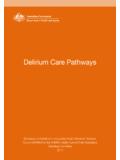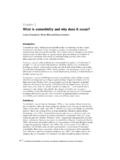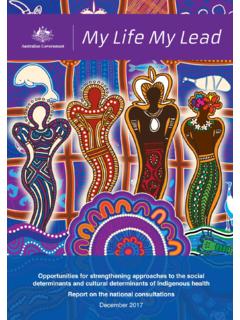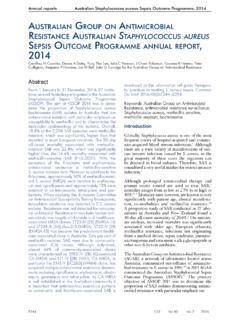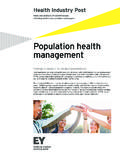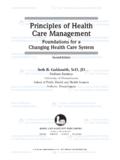Transcription of National E-Health Strategy
1 Australian health Ministers' ConferenceDecember 2008 National E-Health StrategySUMMARY Victorian Department of Human Services, on behalf of the Australian health Ministers Conference (2008) This document may be downloaded from the Australian health Ministers Advisory Council (AHMAC) website at Further information can be obtained from the AHMAC National E-Health and Information Principal Committee (NEHIPC) Secretariat, Department of Human Services, 50 Lonsdale Street, Melbourne VIC 3000. Foreword Australia s health system delivers some of the world s best health outcomes. However, maintaining or improving these outcomes in the face of growing pressures on the health care system will require a fundamental change in the way health care is delivered into the 21st century.
2 Change must address the way information is accessed and shared across the health system, which will in turn transform the way health care professionals practice and consumers interact with the health system. Currently the health information landscape is characterised by discrete islands of information with significant barriers to the effective sharing of information between health care participants. It also poses challenges when trying to understand and report on what is really happening to support population health surveillance and guide policy, service planning, innovation and clinical and operational decision-making. Whilst Commonwealth, State and Territory Governments and the private sector are already investing in various E-Health foundations or initiatives, without some form of National coordination there is a real risk of extensive duplication, avoidable expenditure, and the creation of new solutions that cannot be integrated or scaled across the continuum of care.
3 In early 2008, Australian health Ministers, through the Australian health Ministers Advisory Council (AHMAC), commissioned Deloitte to develop a strategic framework and plan to guide National coordination and collaboration in E-Health . As part of this process, Deloitte conducted a series of National consultations which included Commonwealth, State and Territory Governments, general practitioners, medical specialists, nursing and allied health , pathology, radiology and pharmacy sectors, health information specialists, health service managers, researchers, academics and consumers. An electronic submission process was also used to facilitate wider community input. The National E-Health Strategy developed by Deloitte, together with key stakeholders, provides an appropriate basis to guide the further development of E-Health in Australia.
4 It adopts an incremental and staged approach to developing E-Health capabilities to: leverage what currently exists in the Australian E-Health landscape; manage the underlying variation in capacity across the health sector and States and Territories; and allow scope for change as lessons are learned and technology is developed further. Australian health Ministers Conference The Strategy reinforces the existing collaboration of Commonwealth, State and Territory Governments on the core foundations of a National E-Health system, and identifies priority areas where this can be progressively extended to support health reform in Australia. The Strategy also provides sufficient flexibility for individual jurisdictions, and the public and private health sectors, to determine how they go about E-Health implementation within a common framework and set of priorities to maximise benefits and efficiencies.
5 The ultimate benefit achieved from a National E-Health Strategy is a safer and more sustainable health system that is equipped to respond to emerging health sector cost and demand pressures. Improvements in the Australian health care system will also drive stronger workforce productivity that is integral to Australia s long run economic prosperity. The E-Health Strategy is commended as a useful guide to the next steps for Australia in its E-Health journey. The E-Health Strategy is pragmatic, balances different priorities and will help to lead Australia towards the delivery of a safer, better connected and more sustainable health care system. Katy Gallagher MLA Chair Australian health Ministers Conference Contents 1 1 Australia s health Care System.
6 1 health System Challenges .. 2 health Sector Response .. 3 The National Response .. 4 2 National Vision for E-Health .. 5 Implications of the vision for stakeholders .. 5 The vision in 7 3 National Strategy for 8 Strategic Principles .. 8 Strategy Overview .. 8 Foundations Work Stream .. 10 E-Health Solutions Work 11 Change and Adoption Work Stream .. 16 Governance .. 18 4 E-Health Implementation Roadmap .. 20 Planning 20 Implementation Roadmap .. 20 5 E-Health Outcomes .. 22 E-Health Implementation 22 E-Health 23 National E-Health Strategy Summary Page 1 1 Introduction Australia has one of the best health systems in the world based on the health outcomes of its citizens.
7 However, maintaining or improving the health outcomes of Australians will require a fundamental change in approach to the way health care is delivered in this country. The Australian health system is straining to deal with increasing cost and demand pressures and a shortage of skilled health care workers. Given this reality, we need to move to a system where every interaction between consumers and care providers achieves maximum impact on health outcomes and where scarce financial and human resources are deployed as effectively as possible. Most of all we must draw upon the latent capacity in the system represented by consumers themselves playing a more active role in the protection and management of their personal health outcomes.
8 This change will require a fundamental shift in the way information is accessed and shared across the health system. We have to move away from a reliance on tools such as pen, paper and human memory to an environment where consumers, care providers and health care managers can reliably and securely access and share health information in real time across geographic and health sector boundaries. The only way this can be achieved is through the implementation of world class E-Health capability. The World health Organisation defines E-Health as the combined use of electronic communication and information technology in the health sector. In more practical terms, E-Health is the means of ensuring that the right health information is provided to the right person at the right place and time in a secure, electronic form for the purpose of optimising the quality and efficiency of health care delivery.
9 E-Health should be viewed as both the essential infrastructure underpinning information exchange between all participants in the Australian health care system and as a key enabler and driver of improved health outcomes for all Australians. Australia s health Care System The Australian health care system is one of Australia s largest and most complex industry sectors. It employs over 850,000 people and delivers services to a diverse population of approximately million residents across a very wide range of geographic and socio-economic settings. Services are provided by a complex network of largely autonomous public and private care providers working across over 1,000 public and private sector hospitals and tens of thousands of additional general practice, clinical specialist, community health , allied health and aged care settings.
10 In 2005-06 Australia spent one in every eleven dollars on health which equated to nearly $87 billion or approximately nine per cent of GDP1. The Australian health system is fundamentally important to the country from both an economic and social perspective. A healthy population underpins strong economic growth and community wellbeing and prosperity. Australia is performing very well relative to its international peers in this regard. OECD and Australian Institute of health and Welfare (AIHW) data indicates that at an average of years, Australians enjoy one of the longest life expectancies in the world and falling incidences of many major diseases2. This headline performance, however, hides a number of significant challenges and issues which threaten the future performance and sustainability of the Australian health system if not addressed.
